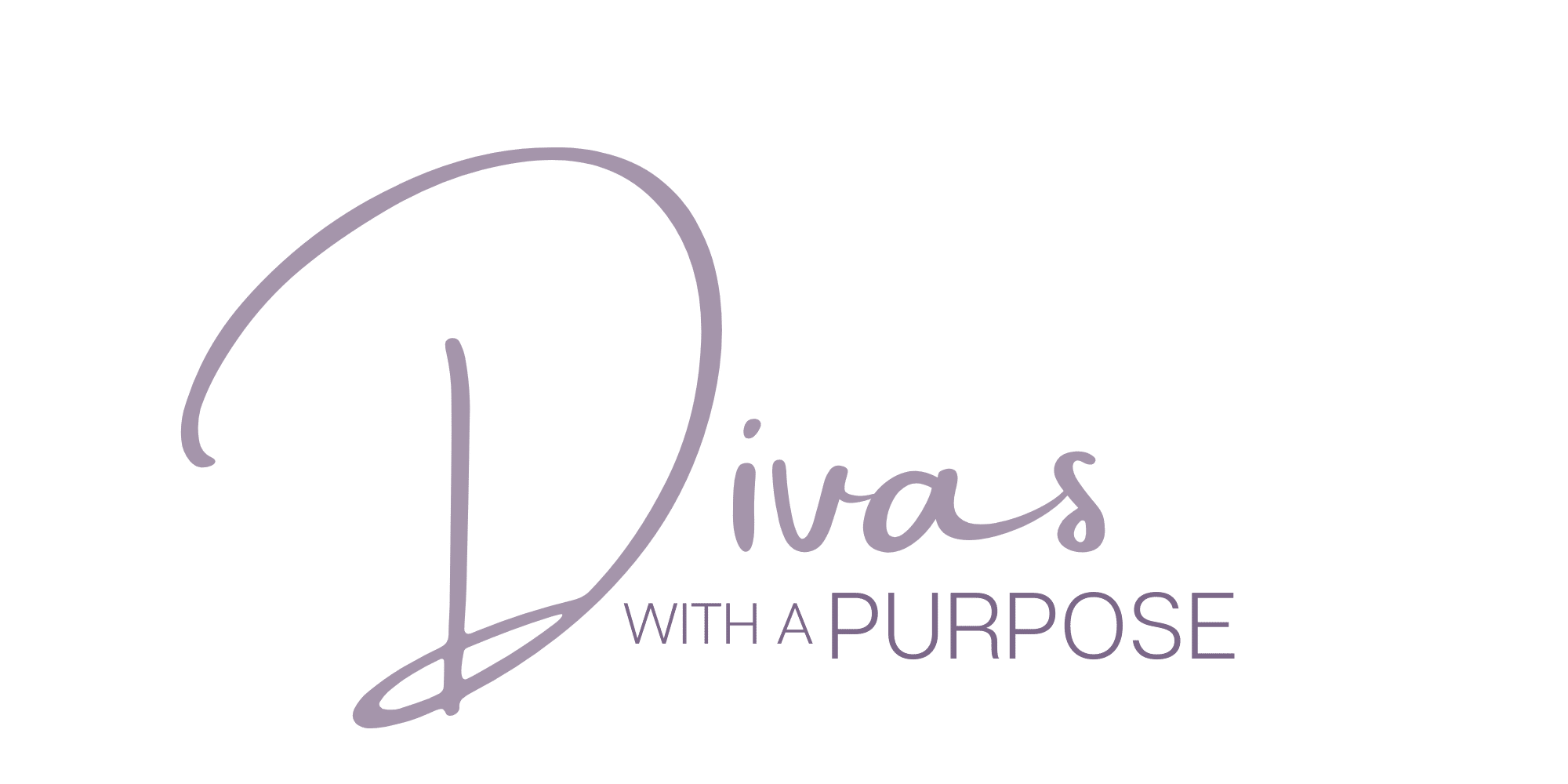Monthly Wellness Themes for Busy Women You Can Keep Up With
Tired of setting self-care goals that fade by week two? When your calendar is full, even a 10-minute stretch feels hard to keep. You’re not alone, and it’s not a willpower problem. Monthly wellness themes offer a better way forward.
Monthly wellness themes keep things simple. One focus per month, small actions, and clear wins, so you build habits without overwhelm. You get steady progress and a bit of variety that keeps motivation up.
This 12-month plan moves with the seasons. Think winter rest and reset, spring clean eating and light movement, summer joy and outside time, fall routines and calm tech habits. Each month includes simple, realistic ideas you can do in minutes, at home, or on the go. Let’s make self-care easy to start and even easier to keep.

Why Monthly Wellness Themes Work for Busy Women
Monthly wellness themes take a big goal and turn it into bite-size action. You set one clear intention, practice it daily in short bursts, and let momentum build. This structure prevents burnout, adds seasonal motivation, and makes room for real life. The result is steady progress that feels doable, even on chaotic weeks.
Avoid Overwhelm with One Focus at a Time
When you commit to one theme per month, you give your brain a single priority. There’s no juggling five habits at once, no guilt spiral. You know what matters right now, so you follow through.
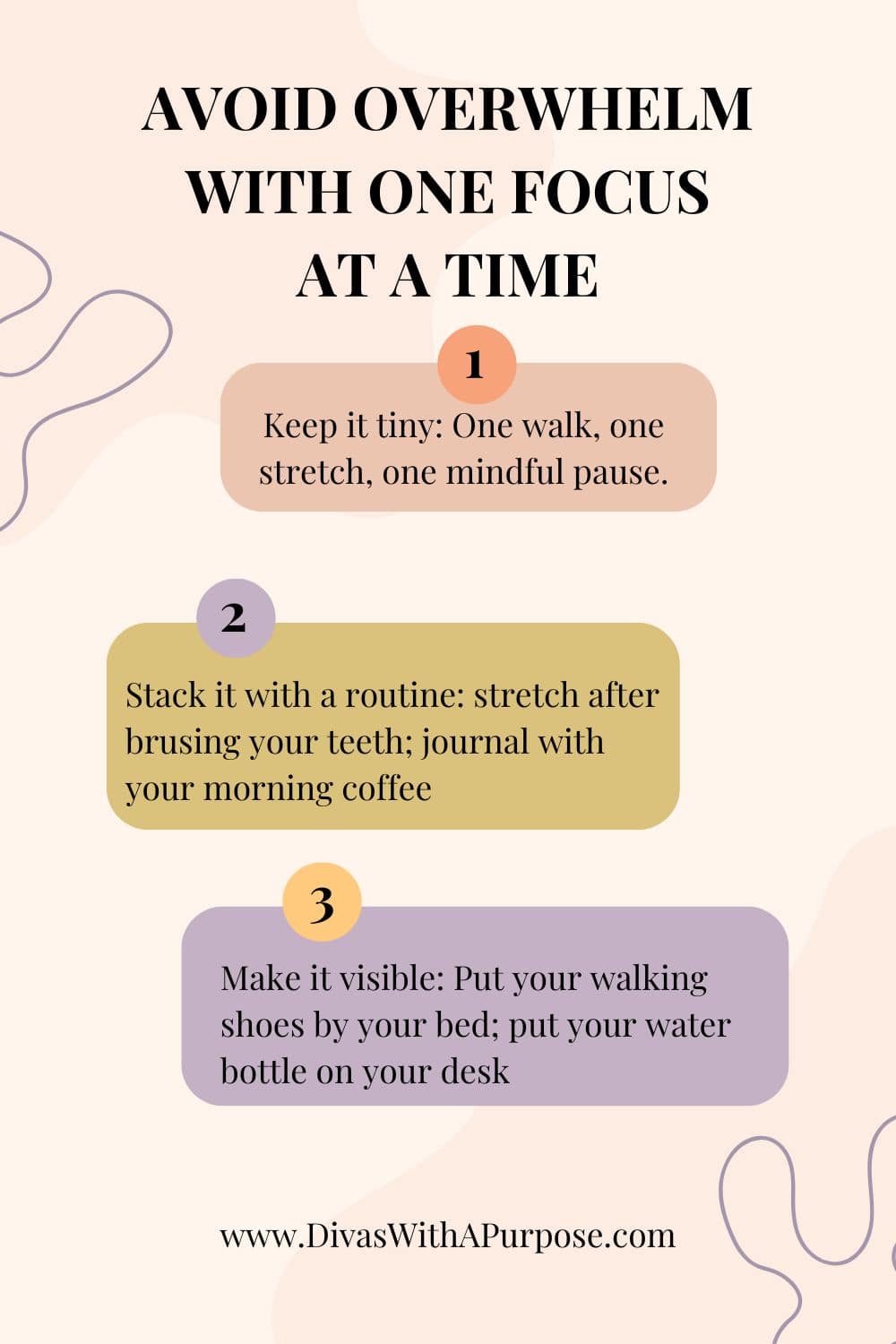
Start small. Aim for 10 to 15 minutes a day to build confidence. That quick win adds a sense of control you can feel.
- Keep it tiny: One walk, one stretch, one mindful pause.
- Stack it with a routine: Stretch after brushing teeth, journal after coffee.
- Make it visible: Put your mat by the bed, keep your water bottle on your desk.
Real-life wins:
- Rinda, a nurse and mom of two, chose “evening wind-down” for January. She did 10 minutes of gentle yoga after the kids’ bedtime. By week three, sleep improved, and her evening scrolling dropped. Monthly wellness themes like ‘evening wind-down’ create this kind of focused progress.
- Tasha, a project manager, ran a “hydrate and move” month. She set a timer to stand, sip water, and do 10 bodyweight reps. Energy went up, afternoon headaches faded.
If you like a guided path, structured challenges can help. The New York Times offers a simple format with daily prompts in The 30-Day Well Challenge.
Tracking without pressure:
- Put a small dot on your calendar for each day you show up.
- Use your phone notes for a one-line check-in.
- Try a simple habit tracker app with one goal only.
Align with Seasons for Natural Motivation
Themes that match the weather, light, and holidays feel supportive. You work with the season, not against it. Winter invites cozy indoor practices and rest. Spring nudges light movement and fresh food. Summer opens up outdoor play. Fall welcomes structure and routine.
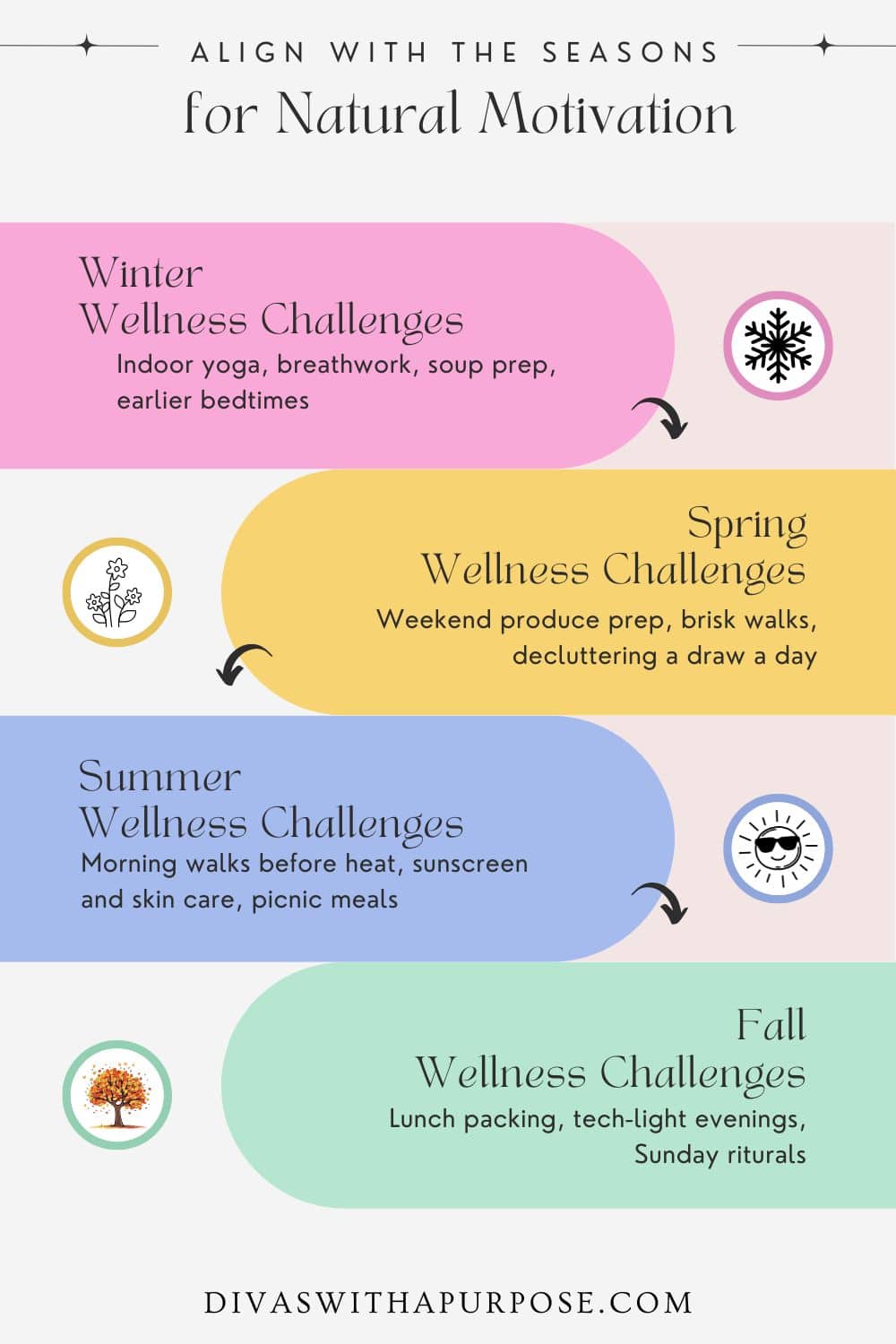
Examples that fit real life:
- Winter: Indoor yoga, breathwork, soup prep, earlier bedtimes.
- Spring: Weekend produce prep, brisk walks, decluttering a drawer a day.
- Summer: Morning walks before heat, sunscreen and skin care, picnic meals.
- Fall: Lunch packing, tech-light evenings, Sunday reset rituals.
Monthly wellness themes built around these natural patterns feel easier to maintain. This seasonal rhythm reduces decision fatigue. You do not force a 5 a.m. run in icy wind or a hot yoga streak in August. Health systems often frame wellness in monthly focus blocks, which can be a helpful model to borrow, like this overview from Prisma Health’s Wellness For Every Month.
Simple ways to stay on track:
- Pair habits with seasonal anchors, like tea at dusk in winter or porch stretch at sunrise in summer.
- Use a monthly sticky note on your fridge with your theme and 3 tiny actions.
Build Lasting Habits Through Variety
Rotating monthly wellness themes keeps your brain interested and prevents the “all-or-nothing” trap. You make progress in layers. Over a year, small wins stack into real change without boredom.
How to keep it fresh and flexible:
- Rotate categories: Body, mind, food, environment, social, sleep.
- Use levels: Have a base action for busy days, a plus action when you have time.
- Personalize monthly goals: Shift your focus if life changes. New baby, travel, or a deadline month may call for lighter goals.
Example path:
- January: Sleep basics, 10 minutes earlier lights-out.
- February: Gentle strength, one 12-minute routine.
- March: Produce boost, add one fruit or veggie to each meal.
- April: Walking streak, 15 minutes after lunch.
If habit science helps you stay engaged, read practical strategies for behavior change in this plain-language guide on building healthy habits that stick.
Quick progress checks, minus the pressure:
- Mark “Y” or “N” each day in a pocket journal.
- Set a weekly reminder to rate your theme 1 to 5, then adjust.
- Do a 2-minute Sunday review: What worked, what was hard, what tiny tweak helps next week?
The biggest benefit is choice. Monthly themes adapt as your needs change. You stay consistent, not perfect, and that is what builds long-term wellness.
Winter Wellness Themes: January to March for a Strong Start
Winter is a cozy season for inner growth. Monthly wellness themes for winter focus on rest, reset, and calm. Shorter days invite slower mornings, warm drinks, and soft routines that support your mood. Use this time to reset your space, steady your heart, and build calm into busy days. Small steps count. The goal is gentle structure that lifts energy, eases stress, and feels good to sustain.

January: Reset and Declutter Your Space and Mind
A lighter environment helps you think clearly and move with less friction. Start with tiny tasks so change feels easy, not heavy.
Try these simple actions:
- One drawer a day: Clear a nightstand or desk drawer. Why it helps: less visual noise, faster mornings. How to fit it in: set a 10-minute timer after dinner.
- Surface sweep: Reset kitchen counters and your entry table nightly. Why it helps: smooth mornings and less decision fatigue. How to fit it in: tie it to the dishwasher cycle.
- Mind dump journal: Write three lines each morning. Why it helps: clears mental clutter and sets focus. How to fit it in: keep a pen with your coffee mug.
- Weekly tidy-up ritual: Pick one hour on Sunday. Why it helps: anchors the week and reduces weekday stress. How to fit it in: play a favorite podcast and set a single goal.
- Clutter basket: Use one basket to collect random items, sort once a week. Why it helps: keeps floors clear without constant trips. How to fit it in: park the basket by the stairs.
If you like structure, try tiny decluttering prompts from How To Declutter Your Home with 12 Tiny Tasks. For mental clarity, this guide on decluttering your mind for the New Year pairs well with morning journaling.
Micro habit idea:
- Put a sticky note on the fridge with three reset tasks. Check one box a day.
February: Nurture Heart Health and Self-Love
Lean into warmth and care by supporting your heart, both physical and emotional, with simple acts that add comfort and connection.
Try these gentle practices:
- Affirmations you believe: Choose one line like “I show up for me.” Why it helps: builds self-trust and steadies mood. How to fit it in: say it while washing your face.
- 10-minute walk dates: Walk solo or with a friend. Why it helps: boosts circulation and clears stress. How to fit it in: loop the block after lunch or a meeting.
- Cozy reading sessions: Keep a book by the couch. Why it helps: calms your nervous system and lowers screen time. How to fit it in: read one chapter before bed.
- Breath-and-release check-ins: Try 4 slow inhales, 6 slow exhales. Why it helps: supports heart rate variability and calm. How to fit it in: do it at red lights or in the bathroom.
- Gratitude text: Send one kind note daily. Why it helps: strengthens bonds and reminds you you are not alone. How to fit it in: pair with your morning coffee.
Micro habit idea:
- Create a “love list” note on your phone with three things you did well today. Update before sleep.
March: Embrace Mindfulness for Daily Calm
As light returns, begin to notice the small moments. Mindfulness helps you stay present, cut stress, and enjoy what is already here.
Start with easy steps:
- 60-second breath breaks: Inhale for 4, exhale for 6, repeat 6 times. Why it helps: resets stress quickly. How to fit it in: before opening your inbox.
- Mindful eating pause: First bite with full attention. Notice taste and texture. Why it helps: improves satisfaction and portion awareness. How to fit it in: do it for the first minute of any meal.
- Mini body scan: Head to toes check, relax your jaw and shoulders. Why it helps: releases tension you forget you carry. How to fit it in: while waiting for the kettle or microwave.
- Phone boundary cue: Put your phone in a basket at dinner. Why it helps: protects presence and conversation. How to fit it in: set a daily alarm titled “phones in basket.”
- Nature glance: Look at a tree or the sky for 90 seconds. Why it helps: lowers stress and sharpens focus. How to fit it in: step to a window between tasks.
Micro habit idea:
- Pick a daily anchor, like brushing teeth, to trigger one mindfulness minute. Keep it the same each day so it becomes automatic.
Keep your winter themes soft and repeatable. A little order in January, a lot of care in February, and small moments of presence in March give you a strong start without burnout.
Spring Renewal Themes: April to June for Fresh Energy
Spring brings longer light, mild air, and a natural lift in mood. Spring’s monthly wellness themes channel this natural energy into sustainable habits. Use it to reset your routine without adding stress. Think short outdoor walks, simple meals with bright produce, and real rest you can feel. Small actions now build steady energy for summer.
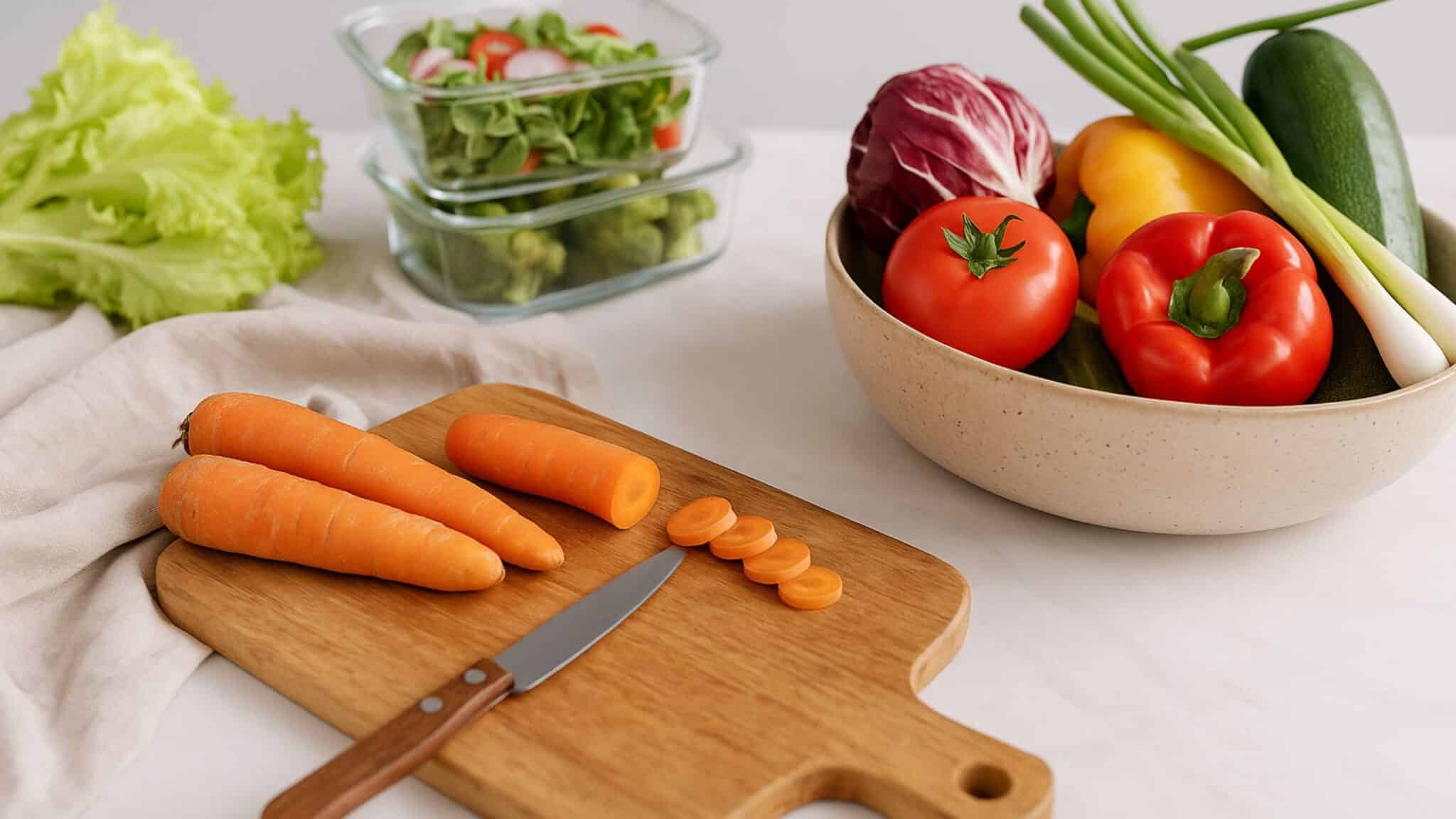
April: Boost Movement with Fun Walks and Stretches
Step outside and let fresh air wake you up. Keep it light and fun. A short walk and a few stretches can raise energy, soothe stress, and help you sleep better at night. Research links regular movement to better sleep quality, which pays off in sharper focus and calmer evenings. See a helpful overview in Exercising for Better Sleep. This makes movement one of the most effective monthly wellness themes for spring.
Try this adaptable routine:
- Beginner, 10 minutes: Easy walk around your block, then 3 gentle stretches, calves, hips, and shoulders.
- Moderate, 20 minutes: Brisk walk in a blooming park plus a 5-minute yoga flow at home.
- Busy day, 5 minutes: Two laps in your hallway or parking lot and a standing hamstring stretch.
Simple structure you can repeat:
- Warm up, 2 minutes of easy walking.
- Main set, 10 to 15 minutes at a pace where you can chat.
- Cool down, 1 minute slower, then stretch major muscles.
Why it helps:
- Walking lifts mood and eases stress, which supports steady energy.
- Light stretching releases tight spots and can support sleep. A controlled study found stretching improved sleep in adults with insomnia, see Effects of resistance exercise training and stretching on sleep.
Track small wins:
- Put a sticky note by the door. Check a box for each walk.
- Use your phone to log minutes, not miles.
- Snap a quick photo of one flower or tree after each walk. Fun proof counts.
May: Fuel Your Body with Nourishing Meals
Fresh produce peaks in spring. Keep meals simple and colorful. Think crunchy greens, berries, snap peas, and herbs. You get fiber, hydration, and steady energy without long kitchen time.
Build a flexible meal rhythm:
- Breakfast: Greek yogurt with berries and a sprinkle of oats. Or avocado toast with lemon and chili flakes.
- Lunch: Big salad with mixed greens, chickpeas, cucumber, and a canned fish or tofu. Add olive oil and lemon.
- Dinner: Sheet pan chicken or tempeh with asparagus, potatoes, and carrots. Bake at 425°F until golden.
- Snack: Apple with nut butter, or hummus with baby carrots.
Meal prep basics for busy weeks:
- Pick 2 proteins, chicken thighs and beans. Cook once, use twice.
- Wash and chop 3 veggies on Sunday. Store in clear containers.
- Make one sauce, like tahini lemon or pesto, to boost flavor fast.
- Keep a “fast plate” list, eggs and arugula, tuna and pickles, cottage cheese and tomatoes.
Intuitive eating cues:
- Start with a check-in. Am I hungry, thirsty, or tired?
- Build balanced plates. Aim for protein, produce, and a smart carb.
- Eat without rushing for the first few minutes. Notice taste and fullness.
- End meals with a pause, one sip of water and a deep breath.
Track small wins:
- Circle days you had one colorful meal.
- Rate energy before and after meals on a 1 to 5 scale.
- Note one dish you enjoyed. Repeat it next week.
June: Prioritize Rest and Relaxation Techniques
Longer days feel exciting, yet they can stretch your energy thin. Rest is the reset button for mood, focus, and hormones. Quality sleep helps appetite signals, stress response, and recovery. Gentle daytime movement also supports better sleep at night, as explained here, Exercising for Better Sleep.
Build a calm evening:
- Power down 60 minutes before bed. Dim lights and reduce screens.
- Short stretch, neck rolls, hip openers, and a slow forward fold.
- Breath cue, inhale for 4, exhale for 6, repeat for 2 minutes.
- Bedtime snack if needed, yogurt with cinnamon or a few almonds.
Daytime recharge ideas:
- 10 to 20 minute nap before 3 p.m. Keep it short to avoid grogginess.
- Nature break, sit on a porch or near a tree for five minutes.
- Reset minute between meetings, shoulder drops and a long exhale.
- Light morning walk to anchor your body clock.
Why it helps:
- Consistent sleep, 7 to 9 hours, steadies cortisol and supports menstrual and perimenopause shifts.
- Short pauses lower stress and improve patience, which you will feel in your body and your mood.
Track small wins:
- Put a star on nights you start your wind-down on time.
- Use a simple 1 to 5 sleep score in your notes app.
- Pick one rest ritual song. When it plays, your brain knows it is time to slow down.
Spring is your chance to grow steady energy with easy habits you can repeat. Keep it light, keep it short, and let consistency do the heavy lifting.
Summer Vitality Themes: July to September for Joyful Living
Summer invites play, color, and connection, making it ideal for monthly wellness themes that prioritize outdoor time, creativity, and gratitude. Use the longer light to recharge your mood, enjoy simple outdoor moments, and add joy to your routine without adding stress. Keep it social, sun-safe, and easy to personalize for your schedule.

July: Get Outdoors for Nature and Adventure
Make July about fresh air and simple adventures. Sunlight supports vitamin D, and time in nature can ease stress, sharpen focus, and lift mood. Research links nature exposure with lower anxiety and better mental health, see this overview on associations between nature and health. Even brief time outside helps. UC Davis also shares approachable ways getting outside supports focus and well-being in 3 ways getting outside into nature helps improve your health.
Try sun-safe, low-lift plans:
- Picnic power: Pack fruit, a protein box, and sparkling water. Pick shade, set a 45-minute timer, and relax.
- Hike lite: Choose a short, well-marked trail. Use a 30-minute out-and-back so timing stays simple.
- Beach day, your way: Arrive early or late, bring a wide-brim hat, mineral sunscreen, and a big water bottle.
- Micro-nature: Lunch on a bench, a 15-minute park walk, or reading on your porch.
Social or solo, both count:
- Solo reset, podcasts and a mindful photo of one thing you loved.
- Group fun, a friend walk, family frisbee, or a sunrise coffee meet-up.
Sun-safe basics:
- Apply SPF 30+ every 2 hours, wear a hat and sunglasses, and seek shade at midday.
- Hydrate, add electrolytes on hot days.
Personalize it:
- Pick your vibe: chill picnic, light hike, or water day.
- Set a tiny target: 3 outside sessions a week, 20 minutes each.
- Choose your window: early morning, lunch break, or sunset.
Mini plan example:
- Tuesday: 20-minute park walk after school drop-off.
- Thursday: Porch dinner picnic with cut veggies and hummus.
- Saturday: Early beach stroll, leave by 10 a.m.
August: Spark Creativity in Your Daily Routine
Let August be your creative month. Small creative acts help mood and confidence. You do not need hours or fancy tools. Ten-minute pockets add up and feel fun.
Low-cost starters for busy days:
- Painting: Watercolor set, index cards, and a cup of water. Paint color swatches or simple florals.
- Writing: Set a 10-minute timer. Use a prompt like “Today I noticed…” Keep it raw and short.
- Gardening: Grow herbs in a window box. Basil, mint, and chives are forgiving.
- Photography: One photo a day of color or texture. Think doors, leaves, shadows.
- Music: Learn one song riff or chorus. Five minutes counts.
Why it helps:
- Creative play boosts joy and self-trust. You make something that did not exist before.
- Tiny wins build momentum. As your output grows, confidence follows.
- Sensory focus calms stress. Hands busy, brain quiet.
Make it stick:
- Keep supplies visible. A small tray with your tools invites action.
- Tie it to a cue. Tea steeping equals 5 minutes of sketching.
- Use a finish line. One page, one card, or one plant task.
Personalize it:
- Pick one medium for weekdays, one for weekends.
- Choose a theme, like flowers, summer skies, or daily haiku.
- Share if it helps you show up, text a friend your “tiny make” on Fridays.
Mini plan example:
- Weekdays: 10-minute morning journaling.
- Saturdays: Watercolor a simple leaf or fruit.
- End of month: Snap a photo of your favorites as a mini gallery.
September: Practice Gratitude to Savor the Good
September carries that back-to-school energy. Use it to frame your days with gratitude. A short practice trains your mind to notice what helps, not just what drains. Over time, this shift supports happier moods and steadier stress response.
Simple gratitude formats:
- Three lines at night: One thing you enjoyed, one thing you learned, one person who helped.
- Sunset reflection: Step outside for 2 minutes. Name three good moments out loud.
- Photo log: One picture a day of something ordinary you appreciate.
- Thank-you notes: One quick text or sticky note a few times a week.
Why it works:
- Attention shift builds perspective. You train your brain to find bright spots.
- Consistency matters more than length. Five honest words beat a long list you skip.
- Connection grows. Sharing thanks strengthens bonds.
Make it fit your life:
- Keep a tiny notebook by your bed or in your bag.
- Use a phone widget with a daily prompt.
- Tie it to an anchor, after dinner or during your skincare routine.
Personalize it:
- Choose a theme, gratitude for health, people, or small joys.
- Pick your style, written, spoken, or visual.
- Set a micro goal, 5 days a week, 2 minutes each.
Mini plan example:
- Weeknights: Write three lines before sleep.
- Sundays: Sunset walk, say your top three out loud.
- Mid-month: Send two thank-you texts to people who made your week easier.
Summer can be simple. A little nature in July, a spark of creativity in August, and a steady gratitude practice in September keeps joy front and center while life stays full.
Fall Balance Themes: October to December for Reflection
Fall is a gentle reset. Monthly wellness themes for fall help you find balance before the year ends. Shorter days and cooler air invite slower rhythms, warm layers, and simple structure before the holidays. Use these months to ground your energy, protect your time, and move into year’s end with ease.

October: Find Balance with Gentle Yoga and Breathing
October is a bridge between busy summer and full holiday calendars. Pair leaf-peeping walks with soft movement to settle your body and mind. A quiet routine now steadies stress and keeps flexibility through colder months.
Try a simple fall flow after a walk:
- Standing forward fold, release your neck and jaw for 3 slow breaths.
- Low lunge on each side, open hips and chest.
- Child’s pose for 5 breaths.
- Seated twist, then legs up the wall for 3 to 5 minutes.
Short breath resets that fit your day:
- Box breathing, inhale 4, hold 4, exhale 4, hold 4, repeat 4 times.
- Extended exhale, inhale 4, exhale 6 to 8 for 1 to 3 minutes.
- Breath cue, smooth inhale as you lift your arms, slow exhale as you lower.
Why it works:
- Gentle yoga and slow breathing calm your nervous system and reduce stress. See how yoga can help you transition into fall.
- Grounding poses and longer exhales help with restlessness common in breezy, dry fall weather. Explore seasonal breathing practices for fall balance.
Make it practical:
- Walk 15 minutes to see the colors, then do a 6-minute stretch on your mat.
- Keep a scarf and socks nearby so you stay warm during cooldowns.
- On busy days, do legs up the wall for 2 minutes before bed. It still counts.
Holiday tie-in:
- Use this routine after decorating, shopping, or travel days. Your back and hips will thank you.
November: Strengthen Connections and Community
As schedules fill, connection reduces stress and lifts mood. You do not need big plans. Small, steady touchpoints build support you can feel.
Simple ways to reach out:
- Send one “thinking of you” text each weekday.
- Plan a walk-and-talk with a friend on Saturday mornings.
- Start a 20-minute Sunday check-in call with a sibling or cousin.
Join or build community:
- Local: library book clubs, walking groups, or a monthly potluck.
- Virtual: a group chat for quick wins, a Zoom coffee circle, or an online class you can do in pajamas.
Why it supports wellness:
- Connection increases accountability and steady mood.
- Shared rhythms make new habits easier. Show up for each other and the habit sticks.
- Stress relief comes faster when you can name your worry to a trusted person.
Keeping it doable:
- Use a cue, text a friend after lunch daily.
- Prepare “easy yes” invites, 20-minute walk, tea on the porch, or a quick video chat.
- Keep a small list of three friends to rotate each week.
Holiday tie-in:
- Set gentle boundaries early, two social yeses per week, one full rest night.
- Start a “bring-a-dish and leave by 8” rule to protect sleep during busy weeks.
December: Reflect and Celebrate Your Progress
Close the year with grace. Pause to review what worked, honor small wins, and set light intentions for the new year.
Do a quick year review:
- What theme helped most this year?
- What tiny habit felt easiest to repeat?
- What drained energy that you can trim next year?
Celebrate progress, big and small:
- Make a “win list” of 12 moments, one per month.
- Create a photo album called “This Year I Showed Up.”
- Treat yourself to a solo coffee date to read your notes.
Gentle closure activities:
- Clear one drawer, recycle old papers, and donate one bag of items.
- Write three thank-you notes to people who made your year easier.
- Choose a cozy ritual, candlelight journaling for 10 minutes or a calm playlist at dusk.
Set soft intentions:
- Pick a word for winter, like Steady, Warm, or Simple.
- Choose one anchor habit for January, lights out 15 minutes earlier or a 5-minute stretch.
- Use a two-tier plan, “base” for full days and “plus” when time opens up.
Holiday tie-in:
- Keep a “buffer day” on your calendar after travel for laundry, food restock, and rest.
- Plan movement as micro-sessions, 8 to 12 minutes, so you keep momentum without pressure.
Fall can be cozy and focused at the same time. Ground now, connect with care, and step into the new year steady and proud.
Tips to Make Your Monthly Themes Stick All Year
Consistency grows from simple systems and kind self-talk. Treat your monthly wellness themes like a friendly guide, not a strict rulebook. Pair each month with tiny cues, quick check-ins, and easy resets so you stay steady even when life gets busy.
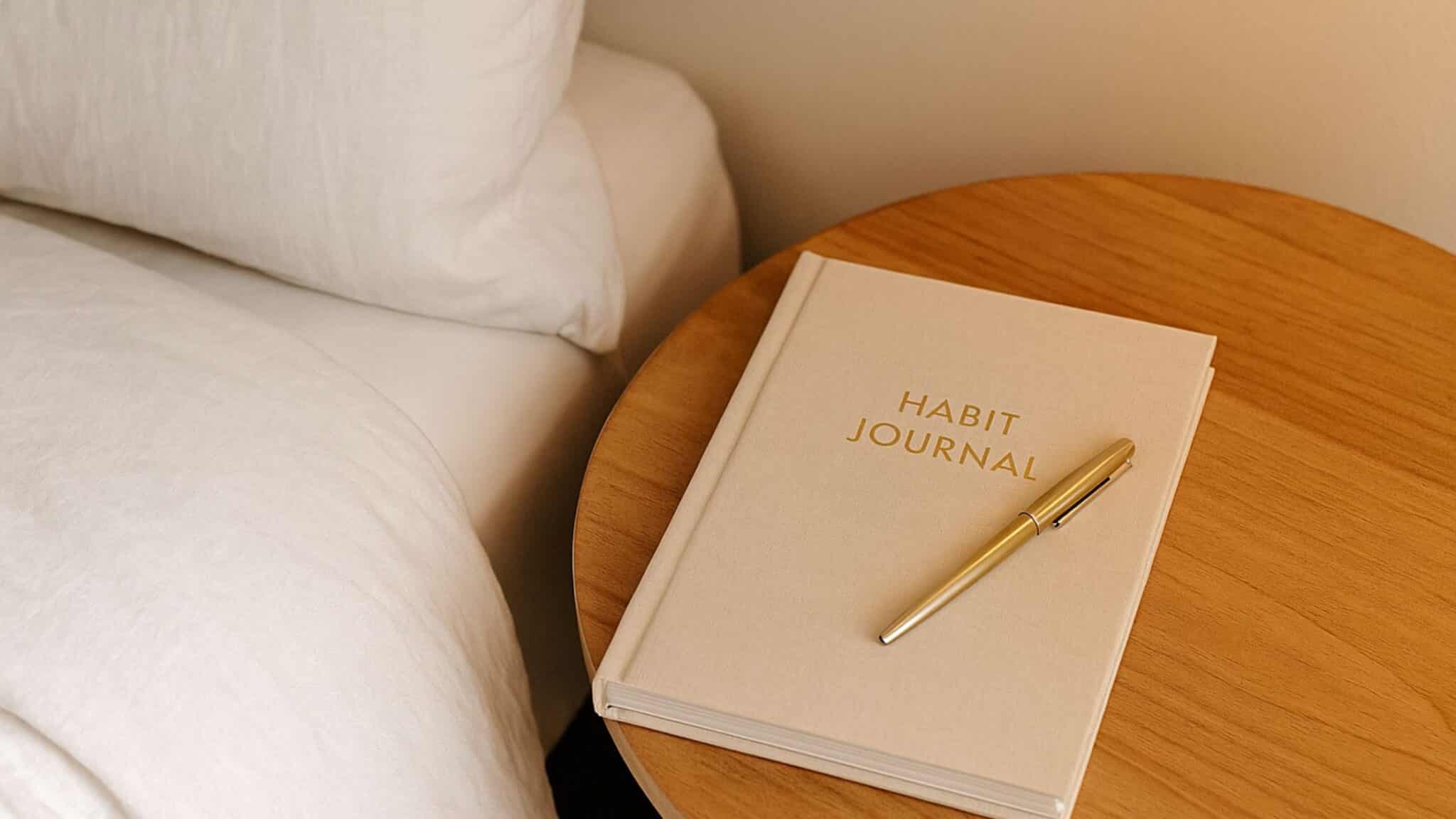
Set Up Simple Tracking Without Extra Work
Keep tracking light and fun so you actually use it. Think phone nudges and one-page planners, not complex charts.
Try these easy setups:
- Calendar pairing: set a daily phone reminder titled with your theme, like “March Mindful Minute.” Add one fun emoji so it feels inviting.
- One-page monthly planner: print a grid and write your three tiny actions on top. Place it on the fridge or your desk. Check a box, add a dot, or draw a smiley. No guilt if you miss a day.
- Keep it visual: leave your mat by the bed, a water bottle on your desk, or your walking shoes by the door.
- Guilt-free rules: streak breaks do not reset your progress, busy-day versions count, and five minutes still wins.
If you love analog, learn a simple, intentional way to track small habits with ideas from Intentional Habit Tracking. Prefer digital support? Review options in this roundup of habit tracker apps and choose one with quick taps and clean charts.
Make it social for gentle accountability:
- Text a buddy a single emoji when you complete your daily action.
- Share a Friday “tiny wins” photo, like your walking view or a finished water bottle.
- Join a small group chat for monthly check-ins.
Keep it light:
- Use a two-tier plan: a base action for busy days, a plus action when time opens up.
- End each week with a 2-minute note: what worked, what to tweak, what to celebrate.
Adapt Themes to Fit Your Unique Life
Your life shifts. Your themes should move with you. Adjust the “how” without changing the “why.”
Make smart tweaks:
- Workdays: turn a 30-minute workout into three 10-minute minis, morning, lunch, and evening.
- Family days: make movement social, stroller walk, dance party, or park circuits while kids play.
- Low-energy or flare days: choose gentle options, breathwork, stretching, or a short outdoors sit.
Use simple planning tools:
- If-then swaps: “If meetings run late, then I do a 5-minute stretch before bed.”
- Micro or plus versions: micro is 5 minutes, plus is 20 minutes. Both count.
- Travel plan: pack resistance bands, set a hotel-room routine, and walk the terminal.
Be kind in the edit:
- Change the target, not the goal. If daily is too tight, try 4 days a week.
- Measure what you can do today. Minutes, sips, pages, and steps all count.
- Forgive gaps fast. Restart with the smallest step and move on.
Accountability that respects your time:
- Pick a buddy with a similar schedule. Share a Monday plan and a Friday check-in.
- Use a short app log, just one tap per day. Review your weekly view, then adjust.
Real-life proof:
- Jenna, a teacher, kept “evening wind-down” all year by using a 10-minute base routine on school nights and a 20-minute plus version on weekends.
- Priya, a new mom, switched May’s “meal prep” to “fast plates” and still saw steady energy because she focused on protein and color, not recipes.
Bottom line: edit your themes to fit your season. Self-kindness keeps momentum, and small wins stack into lasting change.
Your Wellness Journey Starts Here.
Monthly wellness themes make self-care simple, sustainable, and joyful. One focus per month, tiny daily actions, and seasonal rhythm give you steady progress without burnout. You build confidence in minutes, not marathons, and the wins stack up fast.
Pick one theme and start today, sleep basics, mindful minutes, or a short walk. Monthly wellness themes work because they meet you where you are. Small steps change how you feel this week, then shape your year. Share your first theme and one tiny action in the comments so we can cheer you on and grow this community together.
